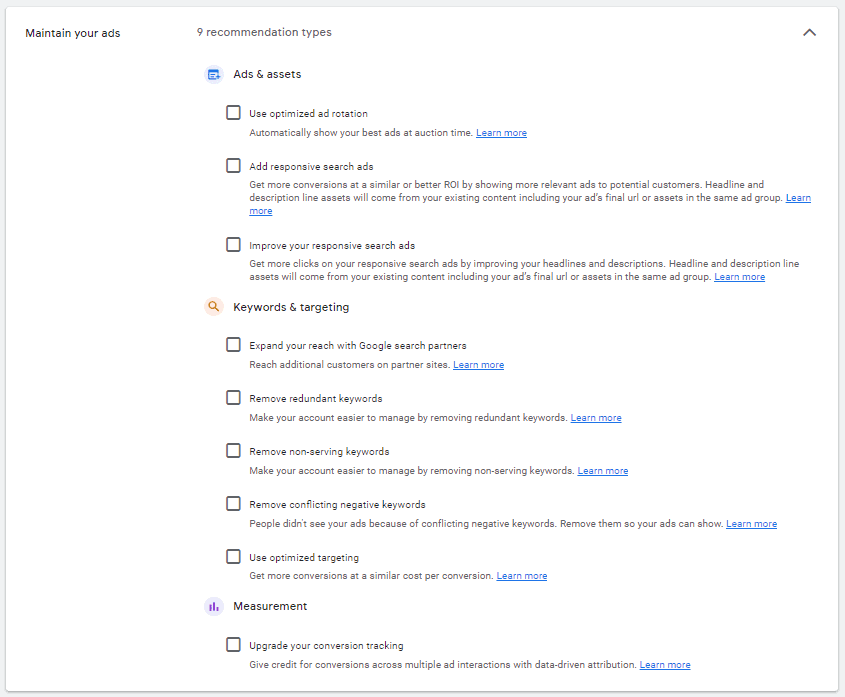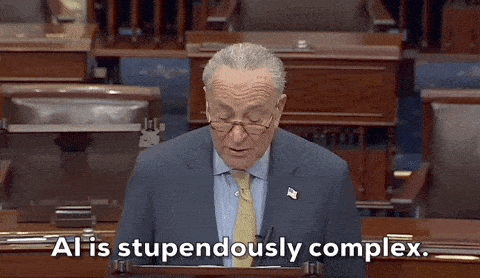Introduction:
Hey there, digital marketing aficionados! Today, we’re diving into the choppy waters of Google Ads and its features, notably the google auto applied recommendations. If you’ve been managing your google ads account for a while, you know the thrills and challenges of navigating the unpredictable waves of online advertising. Picture this: you’re working on your google ads campaigns, and out of the blue, you’re offered a chance to create dynamic search ads or add responsive search ads. The recommendations tab flashes with suggestions, and there’s that shiny new feature promising to make the ad performance smoother.
That’s how we kinda feel about Google Ads’ Auto-Apply Recommendations. Sure, on the surface, they seem like automatically applied ad suggestions based on Google’s machine learning. These auto apply recommendations are tempting—like a siren’s song—luring marketers with the promise of improved conversion rates with minimal effort. But here’s the thing: while dynamic search ads or responsive search ads might be all the rage on search engine land, these google ads recommendations might not always align with your ad group objectives or bidding strategies.

As we discuss this, keep in mind: the world of google ads and auto applied recommendations is vast. And while tools like data driven attribution and optimized ad rotation might seem beneficial, it’s essential to manage auto apply recommendations wisely. They might lead to conflicting negative keywords or even redundant keywords that you’d want to remove. We’ve been around the block, checked our change history tab, and we’ve got some thoughts on these “helpful” google ads auto applied recommendations. Ready to find out if auto apply recommendations are worth the click volume or if they cause too much volatility in your account? Let’s dive in, marketers!
Understanding Auto-Apply Recommendations

Google’s dominance in the realm of digital marketing is irrefutable. With its comprehensive suite of advertising tools catering to a global audience, it has become the go-to platform for marketers. Within the wide array of tools Google offers, one that both entices and perplexes advertisers is the “auto applied recommendations.” But why?
Definition and Basic Concept:
- What is Google auto applied recommendations? Google’s auto-apply recommendations are suggestions put forth by the platform based on an in-depth analysis of an advertiser’s campaign data. These might include proposals such as adding specific negative keywords, refining bid strategies, or turning on particular features. On a superficial level, these come across as constructive pointers aimed at campaign optimization.
Recommendations by Google Based on Data Analysis:
- Google’s unprecedented analytical capabilities mean it can offer insights derived from countless data points. These suggestions, although sometimes beneficial, need to be taken with a grain of skepticism.
Real-life Examples of Auto-Apply Recommendations:

- Advertisers might encounter advice to:
- Introduce specific keywords, aiming to broaden campaign reach.
- Modify bid strategies, potentially promising better ad placements.
- Activate new feature sets which could be pertinent to the campaign’s objectives.
Advantages of Auto-Apply Recommendations:
- Time-saving: Auto-apply recommendations can offer a roadmap, cutting down on manual assessment hours.
- Leveraging Google’s Data Analysis Capabilities: Accepting these suggestions might mean harnessing insights from a vast analytical engine.
Disadvantages and the Allure’s Pitfalls:
- Google’s Recommendations Aren’t Always Aligned: Google’s primary motivation? Its profitability. Thus, a nudge to amplify your bid might elevate visibility but can be detrimental to your budget. Similarly, embracing suggested keywords without a deep dive can result in misaligned clicks and an inefficient ad spend. Google’s recommendations, in essence, might lack the delicate comprehension of an advertiser’s unique objectives and audience.
- Potential for Unwanted Changes if Not Reviewed: The principal allure, the automatic application, is also its major pitfall. If these recommendations aren’t meticulously assessed, they might be auto-applied, leading to unforeseen campaign alterations.
Should I Apply Google Ad Recommendations?
- While some recommendations have their merits, an uncritical acceptance can culminate in less than optimal outcomes. Every suggestion should be evaluated rigorously before any application.
Opting Out of Auto-Apply Recommendations:
- How do I opt out of ad suggestions? If the thought of Google unilaterally altering your campaigns unnerves you, fret not. Advertisers can disable the auto-apply feature. This entails:
- Logging into the Google Ads account.
- Heading to the settings.
- Locating the “ad recommendations” segment.
- Modifying settings to deactivate automatic applications.
Gaining back control ensures advertisers are at the helm, making conscious decisions about their campaigns. As we proceed, we’ll further scrutinize the nuances of auto-apply recommendations, laying out scenarios where they might appear beneficial and underscoring the need for caution.
How Our Company Views Auto-Apply Recommendations
As digital landscapes evolve, Google’s tools, especially the auto-apply recommendations, become more advanced and persuasive. While they may seem promising, our company holds a slightly different perspective, shaped by extensive experience and numerous client interactions. Grounded in our research, client feedback, and insights from our recent video discussion, here’s our stance on Google’s auto-apply recommendations:
The Indispensable Role of Human Judgment:
- Google’s Limitations: Google is a behemoth in data analytics, but there’s one thing it lacks: the ability to understand the nuances and unique dynamics of every business. An algorithm might detect patterns, but it cannot fathom the strategic decisions, brand ethos, or long-term vision of a company. As we emphasized in our video, there’s no replacement for human insight.
Disproportionate Risks for Smaller Enterprises:
- Potential Financial Drains: For budding businesses or those with tighter budgets, an uncritical acceptance of Google’s suggestions can lead to unintentional overspending. A recommendation to amplify bids or expand keywords can deplete limited resources quickly.
- Misalignment with Target Audience: Smaller companies, often operating in niche segments, require precise targeting. Auto-apply recommendations might inadvertently steer campaigns towards broader audiences, diluting the core message and reducing ROI.
The Imperative of Consistent Monitoring and Review:
- Constant Vigilance: While automation promises convenience, it comes at the cost of potential complacency. As highlighted in our video, it’s paramount for advertisers to remain vigilant. Adopting an auto-apply recommendation doesn’t signify the end; it’s merely the beginning of continuous monitoring.
- Routine Assessments: Regardless of whether recommendations are applied, frequent reviews ensure campaigns align with evolving business objectives. Regular checks, paired with human discernment, act as a safety net, catching any misaligned recommendations before they can adversely impact a campaign.
While Google’s auto-apply recommendations offer insights based on vast data analysis, they should not substitute strategic thinking and human judgment. We firmly believe in the blend of technology with human intervention, ensuring our client’s campaigns are not just data-driven, but also vision-aligned.
Best Practices for Harnessing the Power of Automation

In the world of digital advertising, automation has become a double-edged sword. While it promises efficiency, increased reach, and potential cost-savings, it also harbors the risk of detaching advertisers from the intimate understanding of their campaigns. However, with the right practices in place, one can master the art of marrying human expertise with the power of automation. Here’s how:
The Symbiosis of Human Oversight and Automation:
- Augmented Decision Making: Instead of relying solely on automated suggestions, use them as a guide to inform and supplement human decisions. Recommendations can provide valuable insights, but the final call should resonate with an advertiser’s strategic intent and expertise.
- Stay Engaged: Automation doesn’t mean setting and forgetting. It’s crucial to remain actively involved in the campaign, providing a human touch where needed, refining targeting, or adjusting strategies based on real-time feedback.
Periodic Audits & Reviews:
- Scheduled Checks: Establish a routine, be it monthly, bi-weekly, or even weekly, to delve deep into the impact of applied recommendations. Assess key metrics, track changes, and gauge whether the automation aligns with the desired results.
- Feedback Loops: Consider incorporating mechanisms to gather feedback directly from your target audience. Their response can offer invaluable insights, enabling advertisers to recalibrate automated strategies more effectively.
Setting the Stage Before Diving In:
- Objective Clarity: Before enabling any automation, have a clear picture of what you aim to achieve. Whether it’s boosting engagement, increasing sales, or expanding reach, having defined goals ensures that automation serves a purpose and isn’t just a tech novelty.
- Baseline Measurements: Establish baseline metrics before the onset of automation. This offers a reference point, enabling advertisers to quantify the actual impact of automated recommendations over time.
In essence, while automation in Google Ads and similar platforms presents a tempting avenue for advertisers, it’s the harmonious blend of human intuition with technological prowess that charts the road to success. By adhering to these best practices, one can navigate the complexities of automation, ensuring campaigns remain impactful, efficient, and most importantly, aligned with overarching business goals.
Conclusion
In our journey through the world of Google Ads automation, one thing has become increasingly clear: automation, while powerful, is not a one-size-fits-all solution. The dynamic nature of digital marketing, with its ever-evolving landscape and user behavior, necessitates a judicious balance between the efficiency of automation and the precision of manual oversight.
While Google’s automated recommendations present a tantalizing prospect of ease and effectiveness, they must be approached with caution. Advertisers are urged to remember that these suggestions are grounded in broad trends and vast data pools, which may not always align perfectly with niche, specific, or individualized business objectives.

As we advance further into this digital age, staying informed, adaptable, and proactive becomes more critical than ever. It’s not just about leveraging tools and technology but understanding their context, implications, and nuances. In the grand tapestry of Google Ads, let automation be a thread guided by the skilled hands of an informed advertiser.
Work With GrowMyAds.Com
Your experiences with Google Ads, both automated and manual, are valuable threads that contribute to this broader narrative. We invite you to share your insights, challenges, and success stories. Have you found the perfect balance between human intervention and automation? Or are you grappling with the intricacies of automated recommendations?
If you’re looking to delve deeper into optimizing your Google Ads strategies or need a guiding hand in navigating the maze of automation, our team is here to help. Reach out for a comprehensive consultation tailored to your unique business goals and challenges. Let’s harness the power of automation together, ensuring it works for you and not against you



